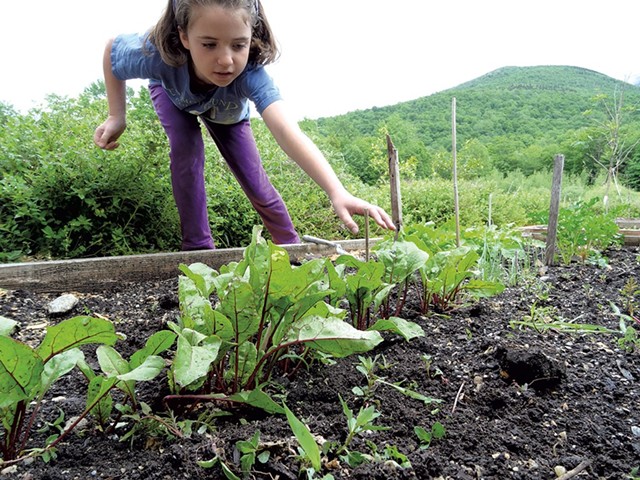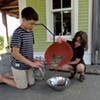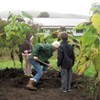Published June 28, 2016 at 10:00 a.m.
My son, Henry has always been a good eater. From a young age, he would munch on just about any vegetable and was willing to try "adult" foods like sushi and mussels. For this, I gave myself a huge pat on the back. No need for an endless parade of chicken fingers and pasta, I thought. All you have to do is put healthy foods in front of them.
Then came my daughter, Lucy. I took the same approach, but she's the pickiest eater I've ever known. Even kid standards like grilled cheese aren't on her list of acceptable foods. This taught me that my son's adventurous appetite had very little to do with me; it's just a part of who he is. (One of many parental bubbles I've had burst over the years.)
However, my daughter, now 9 — and still finicky — will try anything if it comes from the garden. We have a very elaborate kitchen garden full of diverse veggies. She pulls up carrots, rinses them with the hose and chomps away. She'll pick off spinach leaves and eat them like a rabbit. And my kids actually fight over peas when they plump up in early July.
If you have the space and the sun, I recommend starting a backyard garden with your kids. They'll delight in the process, and fussy eaters may be more inclined to try veggies they've had a hand in growing. July isn't too late to start a few rows of carrots and beets. Carrots because, well, who doesn't love carrots? And beets precisely because they're not as popular; the deep color and sweetness may win your kids over and teach them to try new things.
When introducing children to gardening, keep it simple. Plants need space to grow, so keep the area weeded. They also need water, but not too much. Most vegetables like full sun. Their food comes from healthy soil, sometimes with a little help from fertilizer. If you can explain these basic principles to your kids, all the work will make sense.
Growing Guidance
Both carrots and beets come in a variety of colors and shapes. Pouring over the varieties is half the fun, so choose whichever one intrigues your child. Two I like are Purple Haze carrots, which are gorgeous and taste great, and Chioggia beets — they have a cool red-and-white bull's-eye when you cut them open.
Pick a spot for planting that has full sun or at least half a day of direct sunlight. Since these are both root vegetables, make sure the soil is nice and loose at least four to six inches down. Give your kids a trowel or small shovel and have them dig, dig, dig. They will discover rocks, worms and other treasures, and you'll have soil that's ready for planting. If you have compost, mix it into the soil.
Plant the beets and carrots in straight rows about 18 inches apart. Designate a straight line by running a string between two stakes. Make a shallow furrow — a long, narrow trench — down the line. Show your kids how to place the seeds in the furrow evenly, about a half inch apart. There's no need for perfection here: When the seedlings come up, you can thin them to an inch apart by pulling up any seedlings that are clumped together. This is important because if the plants are crowded, their growth will be stunted.
The rest is all weeding and watering. Though weeding is not typically kids' favorite activity, you can encourage them with an enthusiastic, "Let's go give those carrots some space!" Watering is an easy sell, especially on a hot day. But make sure your junior gardeners don't get overzealous with the watering can. A soaking every other day should do the trick.
A few weeks after the seedlings come up, you can give them a boost, either by laying granular fertilizer alongside the row and gently working it into the soil or watering with a liquid fertilizer. Follow the directions on the label and don't give in to the temptation to add more than is recommended.
If all goes well, you should have beets and carrots by late summer or early fall. And, hopefully, you'll find that even your pickiest eater will enjoy harvesting and tasting veggies from your home garden.
This article was originally published in Seven Days' monthly parenting magazine, Kids VT.
More By This Author
Speaking of...
-

Vermont Restaurateurs Add Vegetable Production to Their Long To-Do Lists
Jul 25, 2023 -

Designing Dinner: Lessons From Ellen Ecker Ogden's Kitchen Garden
Jul 5, 2022 -

Age of Asparagus: Planting for the Future as a Link to the Past
May 31, 2022 -

Three Questions for Stone’s Throw Pizza Garden Manager Miranda Dalton
Apr 19, 2022 -

In Starksboro, Marijke's Perennial Gardens Plus Spreads Passion for Native Plants
Apr 5, 2022 - More »
Comments
Comments are closed.
From 2014-2020, Seven Days allowed readers to comment on all stories posted on our website. While we've appreciated the suggestions and insights, right now Seven Days is prioritizing our core mission — producing high-quality, responsible local journalism — over moderating online debates between readers.
To criticize, correct or praise our reporting, please send us a letter to the editor or send us a tip. We’ll check it out and report the results.
Online comments may return when we have better tech tools for managing them. Thanks for reading.















































